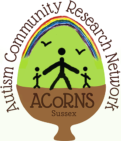What is predictive coding
Our March meeting looked at predictive coding theory which attempts to explain how our brain predicts things. One of the world expert’s in this field, Professor Andy Clark, came along to tell us how this works. He said the brain makes predictions to give us structure and meaning to our world. Our life experiences are based on our sensory input as well as these predictions and we are constantly learning to be more successful in our future predictions. Predictive processing has been looked at for PTSD, Schizophrenia and now Autism, showing the wide application this theory aims to have. 
How predictive coding theory can be related to Autism
The idea is that autistic people experience inaccuracy in the predictions they make. It could be that there is a disruption in these predictions and therefore autistic people rely more on sensory information than on their expectations.
Enhanced sensory experiences
The theory suggests autistic people are more attuned to their sensory input than learnt experiences, which could explain the sensitivities some autistic people experience.
One way to make an accurate prediction is to change your environment to fit your prediction. For example, moving your arm changes your environment. This could underlie repetitive behaviours that some autistic people use, and a desire for routine. Perhaps people want predictability in their life if they experience the world as unpredictable. A member of the group said “People with autism look for sameness because sameness never finds them.”
Metacognition in Autistic people
We then discussed thinking processes in autism. Sometimes autistic people can find apparently simple tasks to be difficult, as there are thousands of possible ways of doing them. We used an example of making a cup of tea: there can be so many choices, such as which spoon, which cup….
Another example is when a young autistic person ate dinner one day but not the next. It turned out that one day the plate was red but the next day it was yellow, a detail that others around him did not notice. These examples highlight the executive functioning differences that might be present in autism. Understanding such differences might lead to better self-understanding and better ways to provide supportive environments.
Diagnosis issues and self-awareness
We raised the important issue of the life stage when people get an autism diagnosis. After a diagnosis, people often want to research and understand further how their thinking processes might be different from those of others. This might be beneficial for some to help them understand themselves. In the optional reading, Ayaya was diagnosed with autism as an adult and talks about how this helped her self-awareness here. She says that she found herself feeling separated from other children because she felt different. But when she was diagnosed, as an adult, she became less anxious, because of the self-knowledge it gave her and the awareness her family and peers now show.
We discussed how having a diagnosis later in life might disrupt your expectations of what you knew about yourself, so quite challenging. Some pointed out that ‘diagnosis’ implies something negative, and can focus on what an individual can’t do, compared to a neurotypical person.
We are currently running a project known as Our stories which aims to create video stories, working with autistic children. This is to help support them in sharing their opinions when they may not be able to verbalise their experiences. It uses a strength based approach by recognising that individual child’s strengths, likes, and hobbies. The video can then be shown to others and leads to a greater understanding of the world through that individual’s eyes.
Seeing through the autism lens
We discussed the importance of putting in the effort to understand autistic people’s point of view. There is lots about autism that we might not know and we must learn from autistic people to support them. For example, research and diagnoses focus on quality of life and success based on neurotypical people. It is important we look at these things from autistic peoples’ perspective. An idea was that there should be more emphasis on the diversity in the neurotypical population. Sometimes it is seen as autism compared to neurotypical but this is inaccurate as there are so many differences in the neurotypical population. We can find crossovers and similarities across all children and should focus on bringing everyone together.
autism that we might not know and we must learn from autistic people to support them. For example, research and diagnoses focus on quality of life and success based on neurotypical people. It is important we look at these things from autistic peoples’ perspective. An idea was that there should be more emphasis on the diversity in the neurotypical population. Sometimes it is seen as autism compared to neurotypical but this is inaccurate as there are so many differences in the neurotypical population. We can find crossovers and similarities across all children and should focus on bringing everyone together.
Just Right program
A program has been developed in Brighton schools to help with emotional regulation. It started as a program to support autistic children but is now being applied for all children. There are different zones- Red (in crisis, overstimulated), Orange (anxious, hyper) Green (calm, ready to learn) and Blue (low mood, bored). It is an easy visual representation for children to explain how they are feeling. It is a helpful way to understand when they are and how they can get back to the green zone to be ready to learn e.g. by having some time out depending on that individual’s needs. A link for more information about this program can be found here. This program is one of the sub-project’s within the Our stories project.
can get back to the green zone to be ready to learn e.g. by having some time out depending on that individual’s needs. A link for more information about this program can be found here. This program is one of the sub-project’s within the Our stories project.
